This is the LAST DAY of a 12 days series of {handmade} Christmas tutorials. Can I get a woot-woot? Make sure to check out the all the projects for 2012, 2010, and 2009!
And I’m hosting myself. Which is why I’m late. Fancy that.
********************
You know those greeting cards that play music when you open them? Well, I want to expand on that theme except that I want music to start playing when you open my front door.
What music, you ask?
“Hello, Darlin’ ” by Conway Twitty, of course.
How awesome would that be? You walk into my front door and all sounds stop except for Conway Twitty blasting out,
“Hello darlin’, nice to see you, it’s been a loooooong tiiiiiime. You’re just as lovely as you used to be.”
Can anybody come wire my house to do that? Pretty please?
Until then, I’ll just have to make do with my Hello Darlin’ pillow.
So, next time you come to visit, I hope you feel the warm welcome that only ‘Hello, darlin’ can bring.
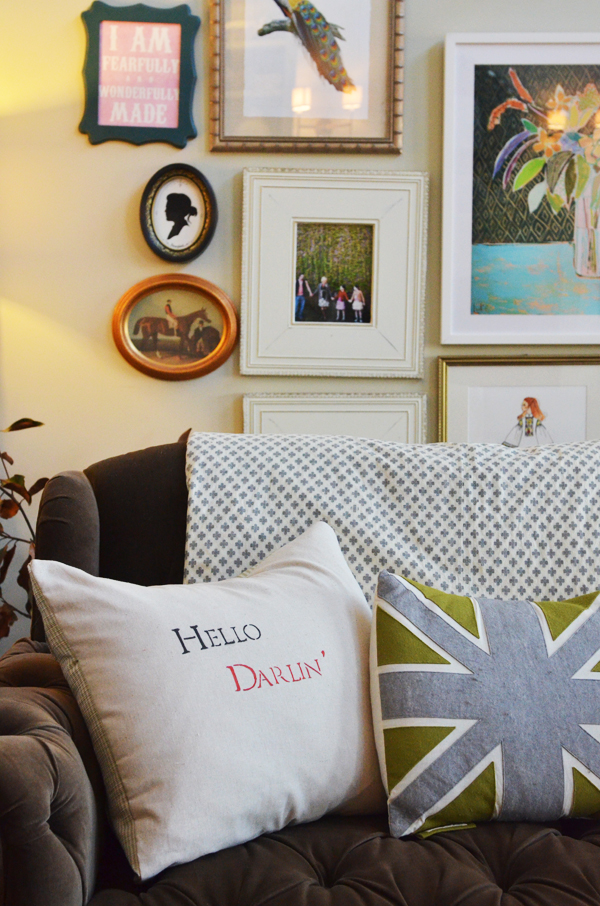 This tutorial is an attempt at combining this tutorial for stenciling pillows and this very easy tutorial for making an envelope pillow!
This tutorial is an attempt at combining this tutorial for stenciling pillows and this very easy tutorial for making an envelope pillow!
Here’s what you’ll need:
stencil of your choice—mine are 1 1/2 inch stencils by Martha Stewart’s from Micheal’s (buy your favorite font, size)
fabric markers—i bought Sharpie’s brand from Amazon.
a pillow cover (blank linen) or just a piece of linen or canvas or cotton fabric cut to the size you want (directions for mine to follow)
a self-healing mat
a rotary cutter
a pencil
a ruler ( I have a lip-edged ruler which has transformed my sewing projects. I LOVE IT!)
Here are a few basic instructions:
Decide on your quote. Which is easy. Hello darlin’ cannot be improved upon, can it? We also made one (or at least Elea did) that says, “You are my sunshine.”
Decide on your spacing. I made a 20×20 pillow cover for this one and once we cut our material, we just laid out the letters and decided how we wanted the spacing. We used a ruler to generally keep the letters straight but I’m not a perfectionist so I don’t waste too much precious time ciphering about it.
As a matter of fact, my 10 and 12 year old did all the work—–the tracing with pencil………
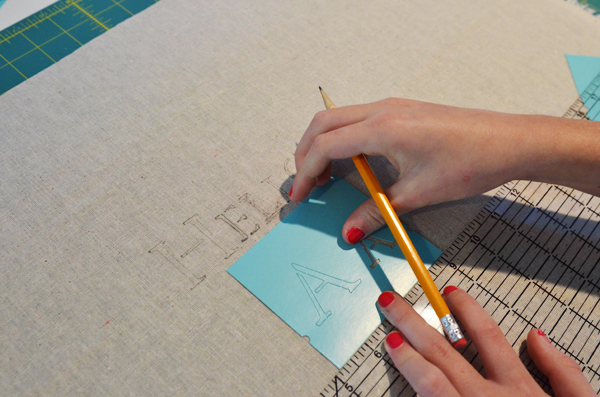
and filling in with the fabric markers.
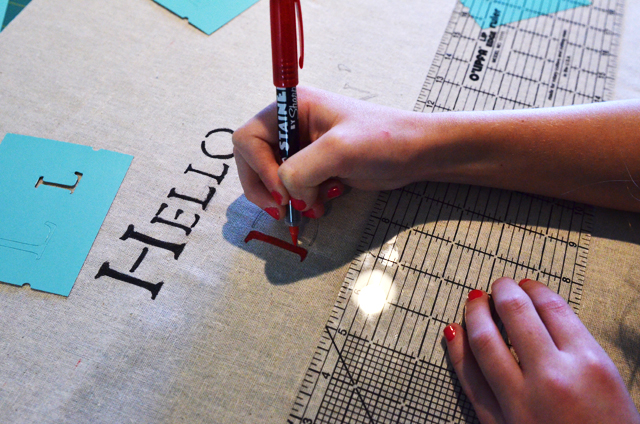
Then you’re ready to make the pillow cover. This is the easiest pillow cover in all of creation. I’ve been making these for years but I found Jenny’s tutorial so easy to understand so I’ll adopt her method of doing it from now on.
You’re basically going to cut a long strip of fabric which you fold over the pillow like an envelope and then sew on the top and bottom.
For a 18 inch square pillow (which I used to demonstrate the technique), I like to make my pillow cover a inch or so smaller so it will fit tight. This works especially well with down inserts, which are much more smush-able when you’re squeezing them into tight spots.
So, for this pillow I cut a piece of fabric 18×42 piece of fabric.
Lay the fabric out so that the longest part is horizontal. Fold over both ends about a half inch (on the 20 inch ends) , iron them and then sew the edges down. This makes the ends look more finished. I don’t know why I did a zig zag stitch here. I usually don’t. Just do a straight stitch.
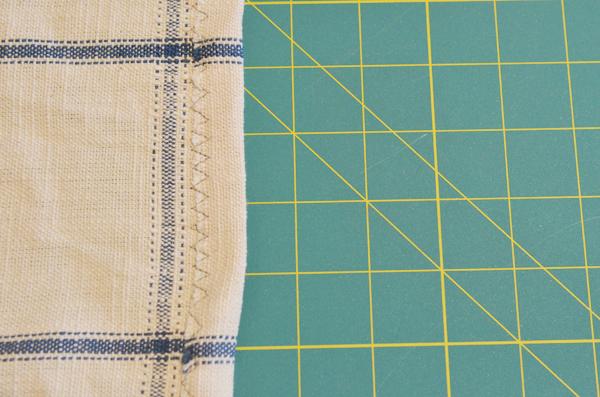
After doing that to both ends, fold the ends in with your fabric right side in, like an envelope.
Once you fold both ends over onto each other, use your ruler to decide how wide you want the pillow to be. I want mine to be 17 inches wide because my pillow insert is an 18 inch square and I want to have to squeeze the pillow in and then fluff it around, giving it a taut appearance. If your insert is 20 inches and you want it to fit not-so-taut, then make it 20 inches at this step. So my ends are folded over, overlapping a few inches with my total width being 17 inches. Now, all I have to do is sew up the top and bottom of the fabric and we’re done. You can turn the pillow cover to the right side through the opening where the fabrics overlap.
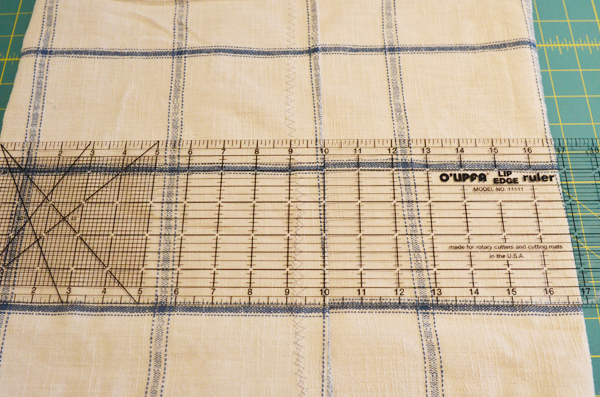
When you sew up the ends, using a 1/2 inch seam allowance, and then turn it to the right side, it looks like this.
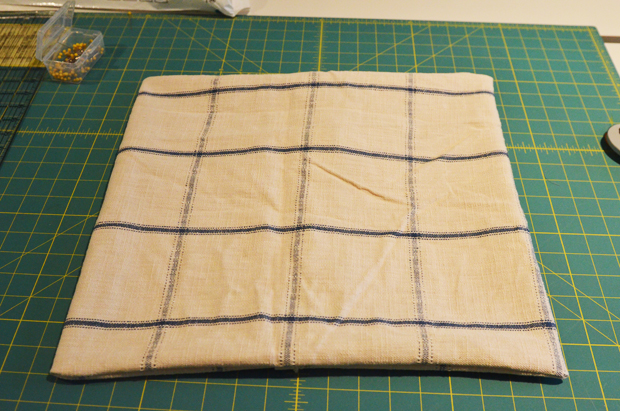
Once you get the hang of these, you can make them in less than 15 minutes.
Here’s how it looks by the Hello Darlin’ pillow.
See how the sides of the pillow aren’t sewn? That’s where you folded the fabric over. The top and bottom are sewn, which makes it the simplest pillow cover to make the entire world!
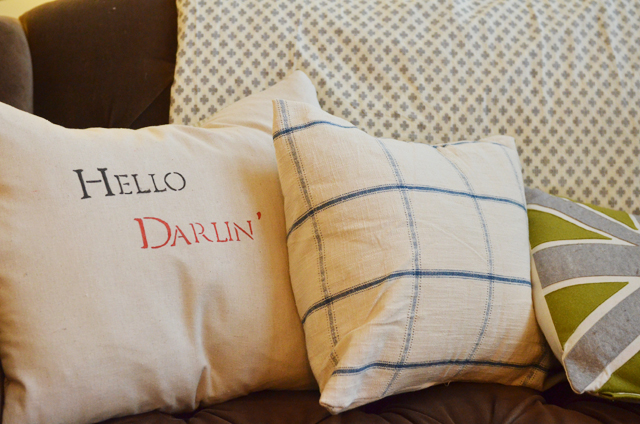
And in case you need a Conway Twitty tutorial……..
